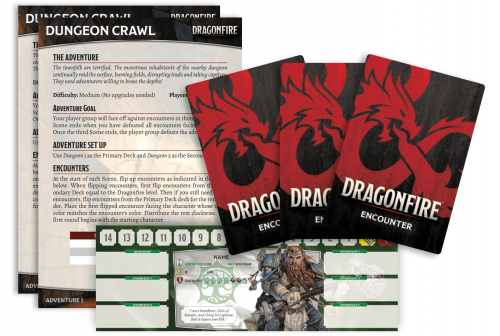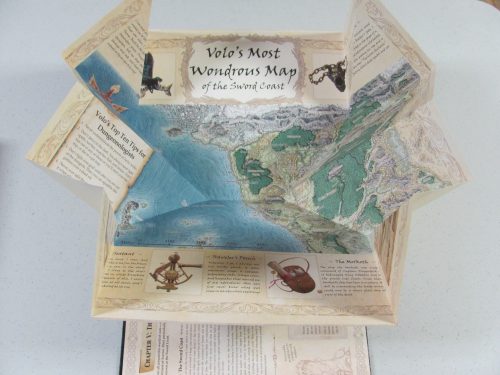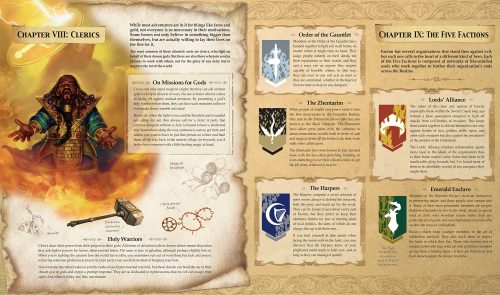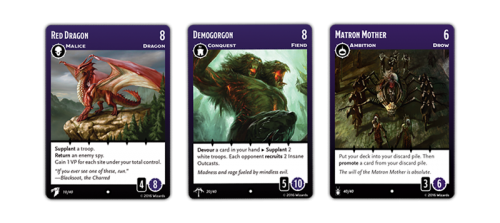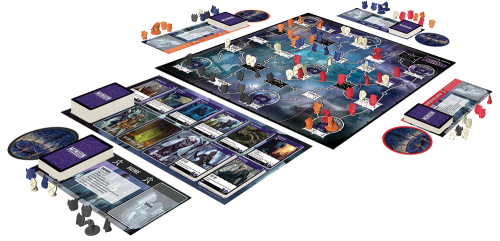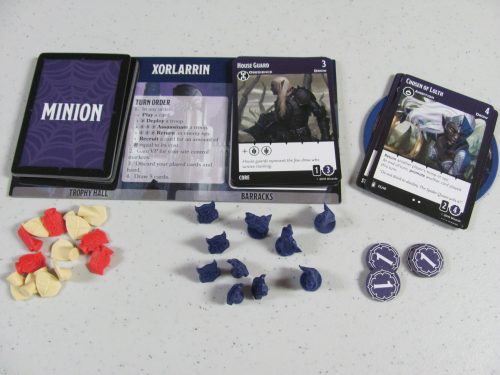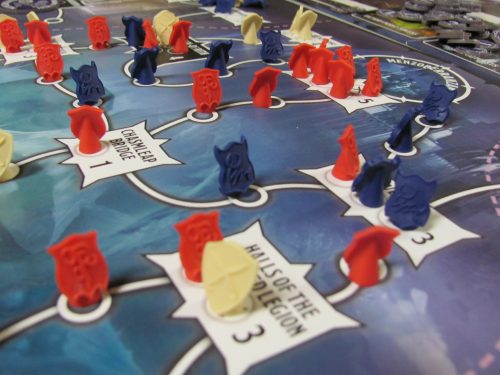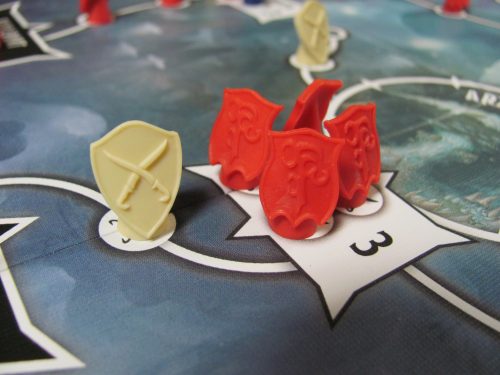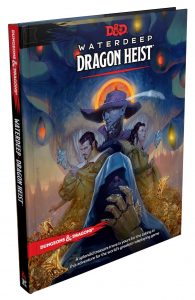 Wizards of the Coast’s Waterdeep Dragon Heist adventure for Dungeons & Dragons is something very different and I’m of two minds about it. Meant for characters levels 1-5, it’s no dungeon crawl, MacGuffin quest, or wilderness expedition, rather an investigative style adventure set in one of the Forgotten Realms’ most famous urban locales. Supplementing that part of the book is a 25 page visitor’s guide to Waterdeep written from the perspective of an iconic Realms character.
Wizards of the Coast’s Waterdeep Dragon Heist adventure for Dungeons & Dragons is something very different and I’m of two minds about it. Meant for characters levels 1-5, it’s no dungeon crawl, MacGuffin quest, or wilderness expedition, rather an investigative style adventure set in one of the Forgotten Realms’ most famous urban locales. Supplementing that part of the book is a 25 page visitor’s guide to Waterdeep written from the perspective of an iconic Realms character.
On the positive side, Dragon Heist provides a distinctive fun adventure for low-level characters, one that combines interesting combat encounters with a variety of roleplaying opportunities, engaging story, and intrigue-filled backdrop. Part of the way through, the players’ characters may end up owning their own city property to use as a base of operations.
I love how Dragon Heist brings the city of Waterdeep to life with social and political factions, historic and mundane locations, and oh so many characters! The complex life of the city is even reflected in the art, which features a number of normal looking street scenes.
On the negative side are difficult to accept plot devices and confusing superfluous content. Now perhaps I should be more willing to suspend disbelief—players in the games I run tend to be a lot more forgiving—but some of these are very weak or poorly constructed. There’s the sentient artifact that resists revealing its secret to anyone but the player characters, the search for a creature that comes down to borrowing someone’s already-made custom detector device, bad guys that bungle their schemes just enough to attract the characters’ attention, and chase scenes rigged for a certain result.
What bothers me the most, though, is not the adventure but the structure of the product. The book takes 60 pages to describe lairs that, if the story unfolds as intended, the players should never visit. And, while the ultimate prize offered the characters is the same, the book presents four alternate antagonists, each with their own extended encounter sequence. The situations faced in these alternate encounters are different but they’re set in many of the same locations. Except, in a way, the secret location of the ultimate prize. That depends, for no apparent reason, on whom the DM has chosen to oppose the characters.
Why this convoluted setup? More than unnecessary, it creates major characters with inspiring motivations for the story line but then asks you to ignore most of them. I suggest two possible explanations. One, it fills out the page count. The essential part of the adventure is just not enough for a $50 hardcover. Or two, it’s designed to support streaming. Four alternatives to a significant part of the story means more variety among the groups streaming their games, as well as improving the possibility of groups playing at home without the whole story being spoilered by a favorite stream.
With all of this in mind, Waterdeep Dragon Heist presents a fine adventure that is particularly well-suited for new players or others who might be looking for more mystery and more role-playing than dungeon-raiding. New Dungeon Masters, however, might find the details, complexities, and difficult plot issues a bit much to handle. Otherwise, it is a fantastic resource for an urban campaign in the Forgotten Realms. There is so much more than the one story in this product to inspire a DM, hints, hooks, locations, legends, and complex characters.
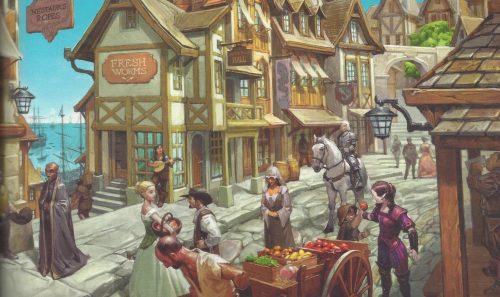
A complimentary copy of Waterdeep Dragon Heist was provided by Wizards of the Coast for review.
Dragonfire—Dungeons & Dragons Deck-building Adventure Game From Catalyst
25 Apr
Posted by David Miller as Modern Board Games, RPGs
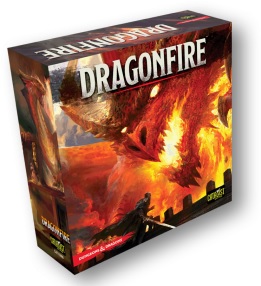 Catalyst Game Labs announced today Dragonfire, a deck-building adventure game based on Dungeons & Dragons and set in the Forgotten Realms. The initial release, “coming soon”, will have players choosing from classic D&D races and classes and beginning their adventure along the Sword Coast. The company also plans future expansions with players leveling up their characters while visiting Baldur’s Gate, Neverwinter, and Waterdeep.
Catalyst Game Labs announced today Dragonfire, a deck-building adventure game based on Dungeons & Dragons and set in the Forgotten Realms. The initial release, “coming soon”, will have players choosing from classic D&D races and classes and beginning their adventure along the Sword Coast. The company also plans future expansions with players leveling up their characters while visiting Baldur’s Gate, Neverwinter, and Waterdeep.
Catalyst is building Dragonfire from the same system the company used for its Shadowrun: Crossfire game (though the two will definitely not be compatible).
Adapting that engine to Dungeons & Dragons is an exciting opportunity to build new ways for players to experience both quick adventures and long-term campaigns in this legendary high-fantasy setting. And at every step, Catalyst has worked hard to remain true to D&D lore. When players open a copy at the table, regardless of what they enjoy playing—RPGs, deckbuilder games, or both—they’ll find a complete box of fun.
Dragonfire will be priced at $60 retail and come with five decks of encounter cards, plus a market deck, magic item deck, character cards, adventure cards, an adventure book, sticker sheets, tokens, plastic clips, and a rule book.
Among the expansions planned are Wondrous Cache (more magic items), Heroes of the Sword Coast (more character cards with new classes and races), and Encounters: Dragonspear Castle (a new adventure with more encounter, magic item, and market cards). Several of the expansions are going to print at the same time as the base game.
- Comments Off on Dragonfire—Dungeons & Dragons Deck-building Adventure Game From Catalyst
Thieves Guild is Next Dungeons & Dragons Board Game from Gale Force Nine
07 Mar
Posted by David Miller as Modern Board Games, RPGs
 Gale Force Nine has another Dungeons & Dragons board game in the works. Thieves Guild, scheduled for an October release, will see the players as thieves, competing to complete quests, develop renown, and achieve the highest rank in the thieves guild. The game’s action will be set in the Forgotten Realms with the board a map of Baldur’s Gate.
Gale Force Nine has another Dungeons & Dragons board game in the works. Thieves Guild, scheduled for an October release, will see the players as thieves, competing to complete quests, develop renown, and achieve the highest rank in the thieves guild. The game’s action will be set in the Forgotten Realms with the board a map of Baldur’s Gate.
If you can’t wait for October, Gale Force Nine should also have this April two expansion cards sets for Tyrants of the Underdark, Aberrations and Undead.
- Comments Off on Thieves Guild is Next Dungeons & Dragons Board Game from Gale Force Nine
Newly Discovered Snail Species Named for Dungeons & Dragons Diety
16 Feb
Posted by David Miller as RPGs
 Scientists exploring caves in central Brazil have discovered a new species of snail and named it Gastrocopta sharae, after the Dungeons & Dragons diety Shar. Other than being the primary antagonist of the Tuesday-night campaign in which I play, Shar is goddess of darkness and caverns in the Forgotten Realms campaign setting.
Scientists exploring caves in central Brazil have discovered a new species of snail and named it Gastrocopta sharae, after the Dungeons & Dragons diety Shar. Other than being the primary antagonist of the Tuesday-night campaign in which I play, Shar is goddess of darkness and caverns in the Forgotten Realms campaign setting.
[via PHYS.org]
- Comments Off on Newly Discovered Snail Species Named for Dungeons & Dragons Diety
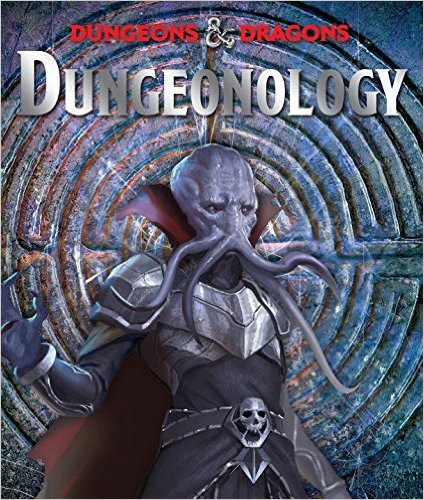 Due out next month, Dungeonology is a different kind of D&D book. It has not a lick of rules for the game and probably not one thing the hard core gamer isn’t already intimately familiar with.
Due out next month, Dungeonology is a different kind of D&D book. It has not a lick of rules for the game and probably not one thing the hard core gamer isn’t already intimately familiar with.
What Dungeonology does have is a nice selection of inspirational D&D art, easy conversational text, fold-outs, inserts, and a dragon hologram. The book contains brief blurbs on iconic D&D monsters, the risks and rewards of adventuring, beginner tips on weapon selection and marching order, highlights of magic spells and treasures, and an overview of the Forgotten Realms, including famous locations, notorious characters, and secret societies.
In short, Dungeonology isn’t a game supplement. It’s an introduction and inspiration, the kind of book you give to your young nieces and nephews to start them off on a lifetime of adventure. The kind that’ll have them choosing characters and itching to roll dice.
Duneonology ($25) is published by Candlewick Press in partnership with Wizards of the Coast. It was written by Matt Forbeck (in the voice of Volotham Geddarm) with an introduction by Ed Greenwood (as Elminster).
A complimentary copy of Dungeonology was provided by Candlewick press for review.
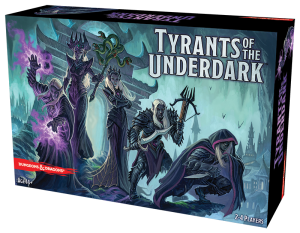 The latest Dungeons & Dragons board game, Tyrants of the Underdark, should arrive at retail within a few weeks and if I didn’t already have a copy it would be for me a must-buy. The game is substantive but not difficult and has a nice balance of interesting mechanics and thematic conflict. I played it with a friend the first time and we immediately wanted to play it again and again.
The latest Dungeons & Dragons board game, Tyrants of the Underdark, should arrive at retail within a few weeks and if I didn’t already have a copy it would be for me a must-buy. The game is substantive but not difficult and has a nice balance of interesting mechanics and thematic conflict. I played it with a friend the first time and we immediately wanted to play it again and again.
Despite its D&D heritage, Tyrants of the Underdark isn’t an adventure game. It makes use of the Forgotten Realms setting but instead of following the RPG style draws on deck-building, area control, and war game inspirations to represent the political maneuverings and intrigue of dark-elf drow society. Players work to place spies, control underground cities, recruit minions, and assassinate opponents. They do this in game terms with two resources: influence for deck-building and power for maneuvering on the board.
The deck-building portion works pretty much like you’d expect. There’s a six card market from which players purchase minion cards representing drow, dragon, elemental, and demon factions. Each turn a player draws five cards from their assembled deck, using the actions and resources on those cards to purchase additional cards, place pieces on the board, capture opponents’ pieces, etc.
On the board are a number of Underdark cities and the pathways connecting them. Control of a city goes to the player with the most troops inside. Getting there, though, normally requires deliberate expansion along the pathways. That is, until one manages to place a spy, which doesn’t exert any control itself but does allow a player to leapfrog intervening enemies and open spaces.
The winner is determined by victory points awarded from a variety of sources. Every city awards victory points to the player controlling it. So do most of the minion cards. One thing I found particularly interesting about the game is how cards a player has managed to remove from their deck (an important strategy in many deck-building games) go up in victory point value. Rather than being considered trashed, the game treats them as if they’ve been promoted to the drow house’s inner circle.
In terms of complexity, Tyrants occupies a middle ground. My friend and I figured out how to play pretty easily from a quick read through the rule book. Only after that first play-through, however, did we start to recognize some of the important strategies. For me at least, though, that’s exactly how the best games work.
Tyrants of the Underdark is a Wizards of the Coast design but is being published by Gale Force Nine. As I said, it should be available at retail within the next few weeks. MSRP is $75 and the game handles 2-4 players in around an hour.
A complimentary copy of Tyrants of the Underdark was provided by Gale Force Nine for review.
- Comments Off on Tyrants of the Underdark Preview
 Although I’ve played various versions of Dungeons & Dragons, I’ve never really played in the Forgotten Realms. (Or any of the published settings for that matter, save Planescape and Spelljammer.) But with Wizards of the Coast’s last three adventure campaigns set the Realm’s Sword Coast, I was excited to see what the Sword Coast Adventurer’s Guide had in store for someone running games in the setting.
Although I’ve played various versions of Dungeons & Dragons, I’ve never really played in the Forgotten Realms. (Or any of the published settings for that matter, save Planescape and Spelljammer.) But with Wizards of the Coast’s last three adventure campaigns set the Realm’s Sword Coast, I was excited to see what the Sword Coast Adventurer’s Guide had in store for someone running games in the setting.
Well, that and the book is a Green Ronin product—a company that makes products I enjoy, including spearheading the Out of the Abyss adventure campaign book—and some people that I know worked on this project. Unfortunately, the Sword Coast Adventurer’s Guide isn’t a book I would recommend for players of 5th Edition.
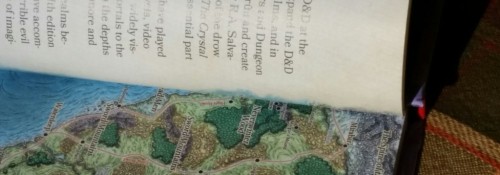
Open the book up to the preface and you see on the right-side page a map of the Realms, extending through the gutter to the margins of the left page. Interesting, but it’s poorly executed. To someone new to the setting—players who have only encountered the Sword Coast through the Starter Set, the three campaign books, or the organized play games — the Sword Coast is their reference point to the Realms. The Sword Coast falls in the gutter, swallowed up by the binding and thickness of the book’s signature. There’s “Neverwin” if you fold the page back far enough. The “Mer…ead Men”. “Luskan ford crossing”.
The map also raises another question: why is it even here? To show how large the Realms are? Well, it cuts off all the Dalelands — pretty much everything east of Cormyr is off the page and the place where the Fifth Edition’s adventures take place isn’t readable. The book is called the Sword Coast Adventurer’s Guide, so why not show off a map of just that area? There is no overall Sword Coast map in the book, just this map of the continent and closeups from it scattered throughout the book. (The map and map segements are done by Mike Schley, who has contributed to most of the 5e line. The full map can be purchased at his site for download.)
I’m spending too much on page 5. Let’s move on.
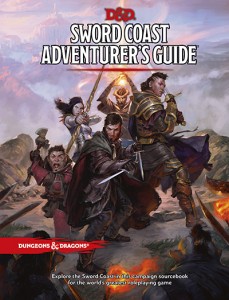 The next section contains incredibly brief passages on areas of the Realms: two paragraphs for The Dalelands (all of them), one on Chessenta, the four nations that make up the Cold Lands get two. There’s a very brief history of the Realms, followed by a lengthy listing of the major deities of the setting. Do you have any of the earlier editions of the setting boxed sets or sourcebooks? More importantly, do you have access to a Forgotten Realms wiki? Not even a minute of searching landed me at the entry for Malar on a Forgotten Realms wiki, which had more information on the Beastlord than this sourcebook.
The next section contains incredibly brief passages on areas of the Realms: two paragraphs for The Dalelands (all of them), one on Chessenta, the four nations that make up the Cold Lands get two. There’s a very brief history of the Realms, followed by a lengthy listing of the major deities of the setting. Do you have any of the earlier editions of the setting boxed sets or sourcebooks? More importantly, do you have access to a Forgotten Realms wiki? Not even a minute of searching landed me at the entry for Malar on a Forgotten Realms wiki, which had more information on the Beastlord than this sourcebook.
Page 43 gets us to a section that’s about the Sword Coast… and the North? Okay, so much more than just the Sword Coast, although the we’re really looking at the cities of the Lord’s Alliance in the Sword Coast region covering the top four inches by one-and-a-half inches of that full-page map. Some cities are shown on callout maps, none of the dwarfholds are. This section is full of in-character recollections of various areas by different adventurers, but they feel like they’re written by the same person. This is the only section of the book that is in first person, and some of the entries in this section can have pages go by between sentences where the fictional author inserts themselves, letting you forget that it’s written in first person. If you want overviews of some of the cities and areas (and don’t have access to a wiki), this is a decent section. But there’s no really deep drill-down into the entries. Don’t expect to run a game set in Daggerford based solely on the information here. Consider this more a “Rough Guide to Faerûn” than a detailed setting bible.
This seems unsatisfying, and it feels that opening up the scope of the setting book from just the Sword Coast to take in all of the area of the North in sixty pages is to blame. If those pages were devoted to just the Sword Coast section (Waterdeep and Daggerford on up north, inland to The High Forest), we’d have a book that has more information about that area. As it is, there’s a lot of high-level information that can be easily found elsewhere. However, the sections at the back of the book appear to be more useful for a setting sourcebook.
The Races of Faerûn chapter is more of how various races fit into the setting. Actual game mechanics amount to sentences like “Sun elves have the racial traits of high elves in the Player’s Handbook” or small sidebars. Tieflings start to branch out to the variety of the “race” from the AD&D Planescape days, instead of demonic half-breeds.
The Classes chapter has a few ways to customize your character, but most seem to be a veneer over the actual class customizations in the Player’s Handbook: This monastic order follows this path in the Player’s Handbook. This druidic group follows this circle found in the Player’s Handbook. This paladin order follows this order in the Player’s Handbook. There are a few things that are neat here: an actual new order for Paladins, two Rogue archetypes, a new patronage path for Warlocks, and a fourth edition Warlord-like archetype for Fighters.
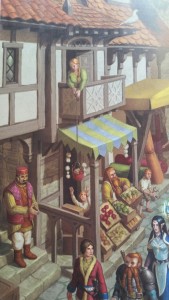 More backgrounds in the aptly-named Backgrounds chapter, but the most fascinating thing here is the M C Escher-level wackiness in the artwork introducing this chapter. There’s a Faction Agent background, but I was under the impression from the Starter Set and the various published campaigns that the five factions in the game were things that the characters join up with as the game goes on. But here, you can choose to be part of The Lord’s Alliance from the get-go. As with the races and classes, many references here to use the traits, ideals, and bonds from exisiting backgrounds in the Player’s Handbook. (Of the twelve background options, only one has a set of these.)
More backgrounds in the aptly-named Backgrounds chapter, but the most fascinating thing here is the M C Escher-level wackiness in the artwork introducing this chapter. There’s a Faction Agent background, but I was under the impression from the Starter Set and the various published campaigns that the five factions in the game were things that the characters join up with as the game goes on. But here, you can choose to be part of The Lord’s Alliance from the get-go. As with the races and classes, many references here to use the traits, ideals, and bonds from exisiting backgrounds in the Player’s Handbook. (Of the twelve background options, only one has a set of these.)
Anyway, that’s the book.
This is a book that wanted to either be longer to fill out… well, everything, really. Or it wants to be a book that focuses on just the Sword Coast.
I would have a rough time recommending this book—it simply doesn’t do the job it wants to. As a setting guide, you can get more out of the Dessarin Valley section in Princes of the Apocalypse to run a whole campaign from. The book doesn’t do much more than a basic wiki for the Realms does, except for the backgrounds and some of the class options. There’s nothing particularly compelling about the Sword Coast Adventurer’s Guide that requires an immediate purchase. A better use of your gaming dollars: buy Mike Schley’s map at his site, and pick up either Princes of the Apocalypse or Out of the Abyss to get enough setting material to run your own overland (Princes) or Underdark (Abyss).
The Sword Coast Adventurer’s Guide retails for $39.95 and is available now.
A copy of the Sword Coast Adventurer’s Guide was provided free by Wizards of the Coast for review purposes.
 Out now is the Dungeons & Dragons Sword Coast Adventurer’s Guide from Wizards of the Coast. The book, a mix of character options and background information, is meant to be a resource for players and dungeon masters using the Out of the Abyss campaign or otherwise adventuring in the Forgotten Realms.
Out now is the Dungeons & Dragons Sword Coast Adventurer’s Guide from Wizards of the Coast. The book, a mix of character options and background information, is meant to be a resource for players and dungeon masters using the Out of the Abyss campaign or otherwise adventuring in the Forgotten Realms.
- Comments Off on Sword Coast Adventurer’s Guide
Trending
- Massdrop.com
- Oh the Irony—Illuminati Card Game Continues to Inspire Conspiracy Theorists
- Home
- Footprints, an Educational Ecology Game
- USPS Adds Board Game Flat Rate Box
- Baila, the Estonian Drinking Card Game
- Crystal Caste Wins Dice Patent Suit Against Hasbro
- Mirror Game, Red and Blue
- Are Board Games Dangerous?
- The Truth About Dominoes On Sunday in Alabama
Archives
Most Popular Articles
- Oh the Irony—Illuminati Card Game Continues to Inspire Conspiracy Theorists
- The 20 Most Valuable Vintage Board Games
- The Truth About Dominoes On Sunday in Alabama
- Sequence Game, and Variants
- USPS Adds Board Game Flat Rate Box
- Baila, the Estonian Drinking Card Game
- The 13 Most Popular Dice Games
- Are Board Games Dangerous?
- Guess Who? The Naked Version
- What Happened to the Jewel Royale Chess Set?
Recent Posts
- Toy Fair 2019—Breaking Games
- Talisman Kingdom Hearts Edition
- Toy Fair 2019—Winning Moves
- Toy Fair 2019—Games Workshop
- Toy Fair 2019—Star Wars Lightsaber Academy
- Toy Fair 2019—Stranger Things Games
- Toy Fair 2019—HABA
- Licensing Roundup
- Game Bandit
- 2018 A Difficult Year For Hasbro But Not For D&D Or MtG
Recent Comments
- on Toy Fair 2019—Winning Moves
- on Game Bandit
- on Second Look—Dungeons & Dragons Waterdeep Dragon Heist
- on Crowdfunding Highlights
- on Beyblade SlingShock
- on Game Bandit
- on Game Bandit
- on Watch This Game!, the Board Game Review Board Game
- on Second Look—Vampire: The Masquerade 5th Edition
- on Palladium Books Loses Robotech IP License, Cancels Five-Year-Overdue Robotech RPG Tactics Kickstarter

